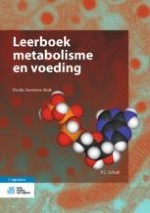Samenvatting
In H. 12 integreren we eerder aangebrachte elementen tot een globaal beeld van het lichaamsmetabolisme. We bekijken eerst de metabole verschillen tussen organen en twee belangrijke parameters: het handhaven van een normale bloedglucoseconcentratie (glucosehomeostase) en het bewaken van een normale voorraad van triglyceriden (vetreserve). Aandacht verdienen de sterke invloed van de voedingstoestand (gevoed, tussen maaltijden, vasten) en hoe insuline, glucagon, adrenaline en cortisol de flux in metabole wegen veranderen. Ook besteden we aandacht aan metabole veranderingen in skeletspieren om kortstondige of langdurige arbeid te ondersteunen. Vervolgens bekijken we diabetes (suikerziekte) als ontsporing van de glucosehomeostase en de rol van pancreatische bèta-cellen die ofwel vernietigd worden door het immuunsysteem (type-1-diabetes) ofwel slecht functioneren (type-2-diabetes). We eindigen met obesitas, een steeds groter wordend probleem voor de mensheid. Net als diabetes is obesitas een vorm van complexe ziekte. Vele risicogenen die elk kleine bijdragen leveren, interageren met een obesogene leefomgeving waarin voeding, beweging en bewuste keuze voor een gezonde levensstijl een rol spelen.
